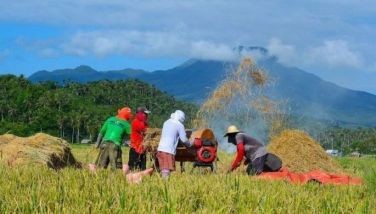Philippines makes headway in Japonica rice production
MANILA, Philippines – Rice production is important to the food supply in the Philippines, with rice being a stable part of the Filipino diet.
The Philippines, a tropical country, is home to Indica rice. Japonica rice, one of the two major eco-geological races of O. sativa, thrives well in temperate countries.
Japonica is a relatively short plant with narrow, dark green leaves and medium-height tillers. Its grains are short and round, do not shatter easily and have low amylose content, making them moist and sticky when cooked.
Cavite State University professor Antonio G. Papa said a study by CvSU researchers titled “On-farm Research Trial on the Adoptability of Japonica Rice Varieties in Cavite” yielded positive results.
The study showed that the three National Seed Industry Council’s approved Japonica rice varieties were suited for tropical cultivation, particularly in the Philippines.
Using three approved Japonica rice varieties by the National Seed Industry Council, namely: NSIC Rc170 (Maligaya Special 11 or MS 11), NSIC Rc220 SR (Japonica 1) and NSIC Rc242 SR (Japonica 2) in the trials, results showed that the yields of the newly approved Japonica varieties were comparable to that of Indica varieties which are best suited for tropical cultivation.
Papa said results of the study showed that the yield of the three varieties during the dry season were high, ranging from 4.3 to 4.6 tons per hectare.
However, only MS 11 had considerable yield during the wet season cultivation with 2.7 tons per hectare.
“Results further indicate that cultivating Japonica rice in Cavite would generate increased income for lowland farmers,” Papa said.
Of the three Japonica varieties, MS 11 yielded the highest profit, both as raw palay or milled rice for both seasons. Japonica 1 and Japonica 2 are preferably cultivated during the dry season than wet season.
“Higher income could be observed if the farmer sells his produce as milled rice than as raw palay. Approximately, a farmer can generate annual net income of P113,059.22 from raw palay and P179,018.37 from milled rice in a one-hectare lowland farm planted to Japonica rice varieties,” Papa said.
Papa said the cultural management practices for Japonica rice production are relatively similar to that of Indica rice varieties which are known to be well adopted in Philippine conditions.
Apart from this, Japonica rice commands higher price than the typical Indica rice varieties because of its excellent eating quality, making it more profitable for rice farmers.
Sensory evaluation results showed that both MS11 and Japonica 2 have no aroma, no off-odor and no off-taste and are cohesive, glossy, tender and smooth. MS11, however, was bland while Japonica 2 was slightly tasty.
The research project was funded by the Department of Science and Technology-Philippine Council for Agriculture, Aquatic and Natural Resources Research and Development (DOST-PCAARRD), in partnership with the provincial government of Cavite.
- Latest





























